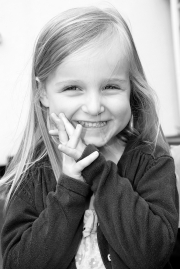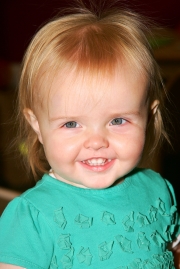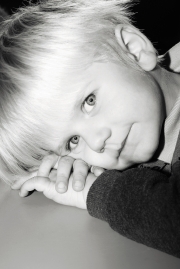Part 2 of 2 – Age specific tips for photographing people.
Here’s a few more tips for taking pictures of particular age groups:
0-1 year olds: Don’t make really abrupt movements. Tiny children sometimes like it but more often than not it scares them and a wailing child doesn’t make a good picture. At this age often the best bet for a smile is to play peek-a-boo from behind the camera but do it slowly and fairly quietly. Big exaggerated smiles and soft tones. At the younger end of this age bracket it’s basically just hit and miss! Babies will almost always react better to people they know so get a parent to try to get a smile while you operate the camera or if you are the parent just do your best. Remember that a straight face or even a sleeping child can make a good picture too so make sure you photograph that as well.
1-3 year olds: Peepo is still a classic but your movements can be a bit more jerky. As they get towards three getting their names wrong often plays out well – even if they’re your own kids – just add ‘pie’ or ‘popasaurus’ or ‘picklepops’ to their names (e.g. Theo-popasaurus, or Annabel-pie, James-picklepops) but really over exaggerate it. The reaction is based on the delivery of the line and words starting with the letter ‘p’ can really be overemphasised. Also at this age they’re used to people taking pictures of them but if you jump as if the flash startled you it often gets a reaction. Fire the camera, jump and ask them ‘who did that?’ with a quizzical expression.
Another favourite for this age group is to balance something on the camera and ask them if they think it’ll fall off or take a picture of them. They’ll look at whatever it is, I use small cars, animal toys etc., and you can get the picture with them looking straight at you. Do it a few times and they might get involved with putting it back on the camera so you get nice interaction as well as response to it falling off. (If it balances really well just shake the camera a bit to get it to fall – they’ll never realise!)
3 and up: Most of the things mentioned above will often work as you move up through the age groups but the children get more self conscious as they get older and can be a bit camera shy. If they’re really shy I put the camera down and just interact with them for a short time. Play in the sand with them, ask what they’re drawing etc. Get in their world and then ask if you can take their picture. Often asking them if they can see you by looking in to the lens gets them to really look at the camera. This is a good trick if they blink a lot or look at the flash – give them something else to look at.
Make sure you show them their picture on the back of the camera, kids love it, but to get some more pictures ask them who it is. Is it mummy? Daddy? They’ll of course say it’s them but say that you need to do another just to make sure. More often than not they’ll sit back down and you can get more shots.
As kids get older you can be more complex in how you get them to laugh as they’ll understand more wordplay. However, parents will always know what tickles their kids so get them involved in generating a smile if they’re not your children but make sure they’re close to the camera or the child will be looking at them instead of in your direction. However, if all else fails get a moody looking off camera shot and print it in B&W. There’s always a shot to be had.
Taking good pictures of children can involve a lot of energy, just look at how hard children’s entertainers work to keep the kids on-side. I’m exhausted after a shoot. You have to be an entertainer as well as photographer so use the above as a starting point and then figure out what works best for you.
Taking good pictures of adults can be just as hard but just engage with your sitter to put them at ease. Chat away and take pictures at the same time. I often say my job is 20% technical and 80% knowing how to deal with people. It’s hard but so worth it when people who don’t like having their picture taken say they love the shots and better than that say they had fun shooting them.




